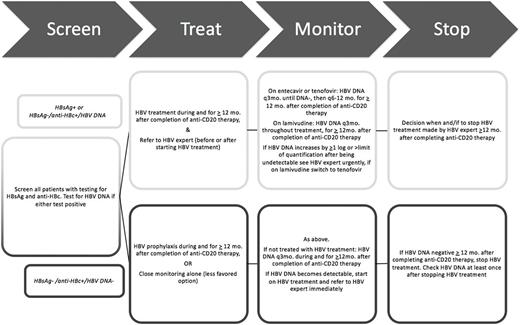Abstract
Background:
Chronic Hepatitis B Virus (HBV) and so-called "resolved" HBV infections (HBsAg negative and anti-HBc positive) can be reactivated secondary to anti-CD20 therapy mediated immunosuppression used in the treatment of cancer and many non-malignant conditions. HBV reactivation can lead to delays in curative chemotherapy as well as HBV specific complications including liver failure and death. Appropriate screening, monitoring and treatment of HBV is integral to the safe administration of anti-CD20 therapies. However, current available guidelines for the management of HBV in patients receiving anti-CD20 therapies rely on a weak body of evidence and provide recommendations that do not adequately address all aspects of care.
Objective:
To provide a unified care map for the management of HBV in patients undergoing treatment with anti-CD20 therapies.
Methods:
A Delphi consensus technique was applied to a multidisciplinary panel of 10 North American experts in HBV or anti-CD20 therapy. The processed occurred over a 20-month period culminating in November 2014. To achieve a comprehensive overview, pharmacists, physicians and a nurse practitioner were included as team members. A preliminary HBV care map was generated based on literature review in conjunction with iterative questionnaires completed by panel members. Panelists were asked to rate their level of agreement across multiple domains of HBV care including screening, treatment and monitoring of patients. Consensus was achieved when there was greater than 75% agreement for all HBV care map elements. The HBV care map was subsequently revised and approved by all members at a face-to-face panel meeting.
Results:
The HBV care map recommends universal screening for all patients receiving anti-CD20 therapy. Patients with positive screening results are stratified into parallel, chronic and resolved HBV tracks. Both patients with chronic and resolved HBV should be started on antiviral treatment (or prophylaxis) prior to beginning anti-CD20 therapy. Entecavir is recommended as first line therapy over tenofovir disoproxil fumarate or lamuvidine. Where cost is a major factor, lamuvidine may be acceptable with close monitoring for viral resistance. Patients require routine monitoring for HBV reactivation (q3-6 months depending on care approach) from the initiation of anti-CD20 therapy until at least one year following discontinuation of immunosuppression. HBV DNA is recommended as the optimal test for HBV reactivation status as it is sensitive and can identify early reactivation events. Monitoring for HBsAg reverse seroconversion can also be used in resolved HBV but is not prioritized in the care map due to limited data demonstrating the safety of this approach.
Conclusion:
The HBV care map incorporates best available evidence and expert consensus building to provide clear and pragmatic guidance to clinicians managing HBV in patients receiving anti-CD20 therapies. In the rapidly changing clinical environment there is a need to quickly respond to growing risks associated with the development of new immunosuppressive treatments. The development of specific and valid guidelines in areas with limited published studies is an i2mportant step in improving the safe delivery of cancer care. This will also serve as the foundation for current and future prospective studies in the care of HBV among immunosuppressed patients.
Crump: Servier: Consultancy, Membership on an entity's Board of Directors or advisory committees; Janssen Ortho: Consultancy, Membership on an entity's Board of Directors or advisory committees. Hwang: Gilead Sciences: Research Funding; Merck: Research Funding. Yim: Gilead Sciences: Consultancy, Honoraria. Zelenetz: Celgene: Consultancy; Amgen: Consultancy. Feld: Gilead Sciences: Research Funding. Hicks: Gilead Sciences: Research Funding.
Author notes
Asterisk with author names denotes non-ASH members.


This feature is available to Subscribers Only
Sign In or Create an Account Close Modal